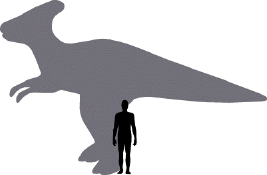
Parasaurolophus
 |
| Length: 33 ft. Weight: 3-4 tons Period: Cretaceous |
The giant tyrannosaur stalked closer and closer. Ready for the attack, she crept up quietly on the grazing duckbill, totally unsuspected. Then, a bugling cry sounded the alarm! The startled duckbill fled her hungry jaws, all thanks to the alarm cry of a watchful Parasaurolophus.
Parasaurolophus Physique
Characteristics of the Crest
The Hadrosaurs
How
Do We Know That?
Mesozoic Timeline
Parasaurolophus lived 65 million to 76 million years ago, at the end of the Cretaceous period. One of the duck-billed dinosaurs, Parasaurolophus roamed North America.
Parasaurolophus
Physique
This dinosaur often grew to
be 33 feet long (10 meters) and 16 feet tall (5 meters).
Parasaurolophus reached weights of 3 to 4 tons (2.7 to 3.6 tonnes).
A thick, pointy tail provided balance when Parasaurolophus ran.
Top
of Page
Characteristics of the
Crest
Top
of Page
The Hadrosaurs
Hadrosaurs were large
dinosaurs, usually from 13 to 49 feet (4 to 14.9 meters) in length.
They walked on all fours but could run on two legs, using a stiff tail
for balance. Variations in skull
shape divide the hadrosaurs into two main subgroups.
The hadrosaurines had flat skulls with bumps of solid bone on the snouts.
The lambeosaurines (including Parasaurolophus) had skulls with long,
hollow bony crests.
Top
of Page
How
Do We Know That?
Parasaurolophus skulls
discovered in Canada, the United States, and Mexico have led scientists to
believe that the dinosaur’s gender was indicated by crest shape.
A medium-length, curved crest indicated an adult female Parasaurolophus.
Adult males had long, curved crests.
Parasaurolophus juveniles had short, straight crests.
